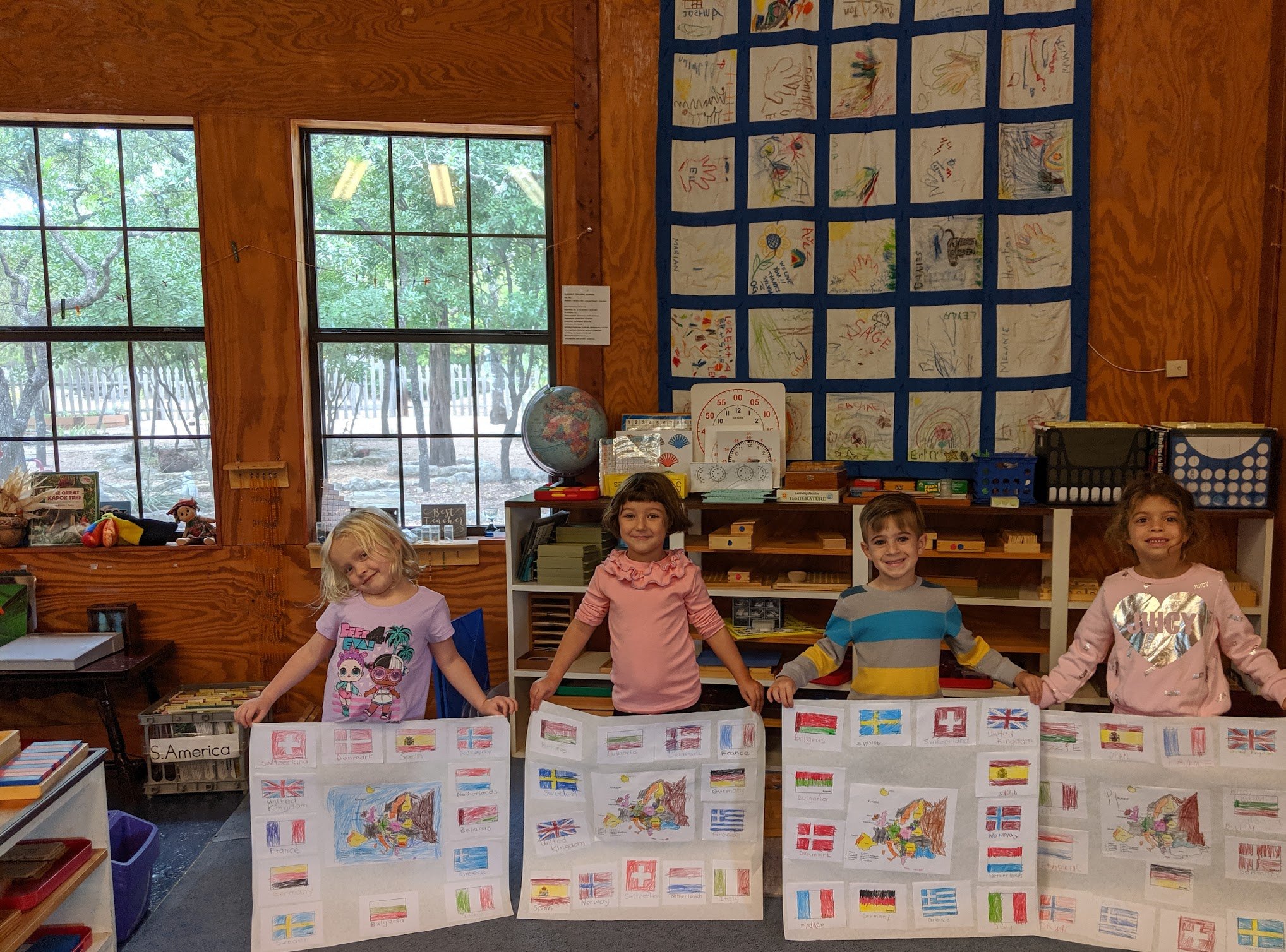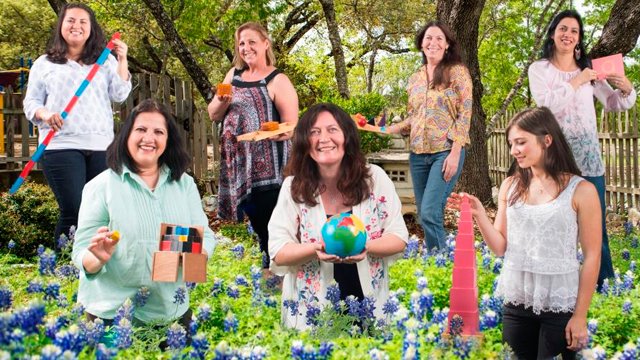
The Montessori Environment
The Montessori materials
The Montessori classroom offers unique self–teaching materials, some of which may, at first glance, seem unsuitable for a classroom. However, these materials, such as sea shells, tongs, and clothespins, provide stimuli that capture children’s attention and initiate a natural form of concentration. Children use these specialized materials to develop coordination skills, attention to details, and good work habits. Because the materials are specifically designed to be self-correcting for errors, they enable children to learn on their own under the guidance of their teacher, and develop their self-confidence and independence as a result.
Differences between a traditional classroom and a Montessori classroom
In a Montessori classroom, children learn according to their own pace using hands-on materials, called manipulatives. Teachers introduce materials to a child systematically and depending upon his developmental needs. The classroom is organized to promote self-discipline, responsibility, and independence. Consequently, a creative atmosphere that is calm co-exists with sufficient classroom structure to encourage learning.
Additionally, there are significant ideological differences between a Montessori classroom and a traditional classroom, as compared in this table:
-
Montessori Classroom:
Education is life in process, beginning at birth.
Traditional Classroom Education:
Education happens in school to prepare the child for life.
-
Montessori Classroom:
The supporter, guide
Traditional Classroom Education:
The leader, lecturer
-
Montessori Classroom:
Individualized, at levels consistent with a child’s abilities
Traditional Classroom Education:
Group-oriented, at group's or teacher's pace
-
Montessori Classroom:
Follows a psychological order
Teachers provide new material when the child is ready, when his interests are piqued.Traditional Classroom Education:
Follows an arbitrary curriculum as set by the school or teacher
-
Montessori Classroom:
Direct, first-hand through use of a wide variety of purposeful learning material
Focus is upon activity and learning by doing.
Traditional Classroom Education:
Tends to be second-hand, with information delivered through lectures and explanations
Focus is upon listening to and accepting authority and learning by rote.
-
Montessori Classroom:
A child can recognize and correct an error by himself, as the teaching materials are self-correcting.
The child experiences positive feelings of accomplishment and builds self-confidence and independence.
Traditional Classroom Education:
The teacher is usually the evaluator.
A child gains recognition by pleasing the teacher or by capturing the admiration of the group.
-
Montessori Classroom:
Is self-initiated through environmental stimulation
Traditional Classroom Education:
Is teacher-initiated or comes from the child’s desire to emulate or please the teacher or group
-
Montessori Classroom:
Develops within the child himself via self-discipline
He develops self-respect and in turn, respect for others.
Traditional Classroom Education:
Rules are externally imposed on the child
Respect is demanded of him.
Advantage of a mixed-age classroom
Montessori classes bring children together in multi-age groups, usually spanning three-year age levels (3-6, 6-9, 9-12, for example). As children stay with their teachers for three years, teachers develop close and long-term relationships with their students, and there is a strong sense of community among the children.
Additionally, younger children have the opportunity to learn by observing their older peers, and older children gain confidence by sharing their experiences. This interaction fosters independent learning and creates a stimulating classroom atmosphere. This age range also provides especially gifted children the stimulation of intellectual peers, without requiring that they skip a grade and feeling emotionally out of place.
Another benefit of a mixed-age classroom is that only 1/3 of the classmates change every school year, as the oldest students move into the next age group. The remaining students return to the same classroom and the same teacher, which provide continuity and develop a fairly stable community each school year.
Montessori class size
Montessori classes typically have twenty-five to thirty children, covering a three-year age span. This larger class size differs from traditional classrooms that have fewer children and are set up with the teacher as the primary instructor.
In contrast, in a Montessori classroom, the focus is not on the teacher, but rather, on the children themselves, as they learn best from each other. As the younger children observe and learn from their older peers, and the older children develop their confidence by sharing their experiences within this larger group setting, they are encouraged to learn from each other and build their sense of community.
Benefits of a five-days-a-week program
Because the primary goal of the Montessori Method involves creating a culture of consistency, order, and empowerment, most Montessori schools expect children to attend five days a week.
Importance of beginning at age three
Maria Montessori identified four “planes of development” with each stage having its own developmental characteristics and developmental challenges. The Early Childhood Montessori environment for children age three to six is designed to work with the “absorbent mind,” “sensitive periods,” and the tendencies of children at this stage of their development.
Learning that takes place during these years comes spontaneously without effort, leading children to enter the elementary classes with a clear, concrete sense of many abstract concepts. The Montessori Method helps children to become self-motivated, self-disciplined, and to retain the sense of curiosity that so many children lose along the way in traditional classrooms. They tend to act with care and respect toward their environment and each other. They are able to work at their own pace and ability. The three-year Montessori experience tends to nurture a joy of learning that prepares them for further challenges.
This process seems to work best when children enter a Montessori program at age two or three and stay at least through the kindergarten year. Children entering at age four or five do not consistently come to the end of the three-year cycle having developed the same skills, work habits, or values.
Older children entering Montessori may do quite well in this very different setting, but this will depend to a large degree on their personality, previous educational experiences, and the way they have been raised at home. Montessori programs can usually accept a few older children into an established class, so long as the family understands and accepts that some critical opportunities may have been missed, and these children may not reach the same levels of achievement seen in the other children of that age. On the other hand, because of the individualized pace of learning in Montessori classrooms, this will not normally be a concern.
The Montessori Teacher
Great teachers help learners get to the point where their minds and hearts are open, leaving them ready to learn. In effective schools, students are motivated more by a basic love of learning, instead of the goal of achieving good grades. As parents know their own children’s learning styles and temperaments, Montessori teachers develop a similar sense of each child’s uniqueness by spending many years with the students and their parents.
Maria Montessori believed that teachers should focus on the child as a person, not on the daily lesson plan. Montessori teachers lead children to ask questions, think for themselves, explore, investigate, and discover. Their ultimate objective is to help their students to learn independently and retain the curiosity, creativity, and intelligence with which they were born. Montessori teachers are facilitators, mentors, coaches, and guides.
Typically, Montessori teachers do not spend much time teaching lessons to the whole class. Their primary role is to prepare and maintain the physical, intellectual, and social/emotional environment within which the children work. A key aspect of this is the selection of interesting and developmentally-appropriate learning activities to meet the needs and interests of each child in the class. Montessori teachers usually present lessons to small groups of children at one time and limit lessons to brief and very clear presentations. The goal is to give the children just enough to capture their attention and spark their interest, intriguing them enough that they will come back on their own to work with the learning materials.
Montessori teachers closely monitor their students’ progress. Because they normally work with each child for two or three years, they get to know their students’ strengths and weaknesses, interests, and personalities extremely well. Montessori teachers often use the children’s interests to enrich the curriculum and provide alternate avenues for accomplishment and success.
The Montessori classroom, also known as the “Children’s House”
Maria Montessori’s focus on the whole child as a person led her to develop a very different sort of school from the traditional teacher-centered classroom. To emphasize this difference, she named her first school the Casa dei Bambini or the “Children’s House.”
The Montessori classroom is a carefully prepared environment designed to facilitate the development of the children’s independence and sense of personal empowerment. This is a place for children. They move freely, selecting work that captures their interest. The furniture is sized for them. The materials are placed on shelves that are easy to reach. The children normally go about their work so calmly and purposely that it is clear to even the casual observer that they are the masters in this place: The “Children’s House.”
“Normalization” within Montessori Schools
“Normalization” is a Montessori term that describes the process that takes place in Montessori
classrooms around the world, in which young children, who typically have a short attention span, learn to focus their intelligence, concentrate their energies for long periods of time, and take tremendous satisfaction from their work.
In his book, Maria Montessori: Her Life and Work, E.M. Standing described the following characteristics of normalization in the child between the age of three and six:
• A love of order
• A love of work
• Profound spontaneous concentration
• Attachment to reality
• Love of silence and of working alone
• Sublimation of the possessive instinct
• Obedience
• Independence and initiative
• Spontaneous self-discipline
• Joy
• The power to act from real choice and not just from idle curiosity







